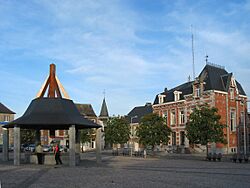Philippeville facts for kids
Quick facts for kids
Philippeville
Flipveye (Walloon)
|
||
|---|---|---|

Philippeville's main square
|
||
|
||
| Country | Belgium | |
| Community | French Community | |
| Region | Wallonia | |
| Province | Namur | |
| Arrondissement | Philippeville | |
| Area | ||
| • Total | 156.71 km2 (60.51 sq mi) | |
| Population
(2018-01-01)Lua error in Module:Wd at line 1575: attempt to index field 'wikibase' (a nil value).
|
||
| • Total | Lua error in Module:Wd at line 1,575: attempt to index field 'wikibase' (a nil value). | |
| Postal codes |
5600
|
|
| Area codes | 071 | |
| Website | www.philippeville.be | |
Philippeville (pronounced fee-leep-veel; in Walloon: Flipveye) is a city and municipality in Wallonia. It is located in the province of Namur, Belgium.
The Philippeville municipality includes several smaller towns and villages. These are Fagnolle, Franchimont, Jamagne, Jamiolle, Merlemont, Neuville, Omezée, Roly, Romedenne, Samart, Sart-en-Fagne, Sautour, Surice, Villers-en-Fagne, Villers-le-Gambon, and Vodecée.
Contents
History of Philippeville
How Philippeville Was Founded
In the early 1500s, the area around Philippeville was a borderland. It lay between the lands of Charles V (the Burgundian Netherlands) and Francis I (France).
Fighting began in 1554 when Henry II became king of France. This forest-covered area was perfect for attacks. It was not very populated and was divided between different regions. Old forts in the area were captured and looted. The fortress of Mariembourg and the town of Givet soon fell to the French.
In 1555, Charles V's new commander, William the Silent, built a new fort. He chose the village of Echerennes for this. The fort was finished very quickly, in just four months. Troops were stationed there right away.
In 1556, Charles V named his new fortress Philippeville. He did this to honor his son, Philip II of Spain. Philip would later take over the rule of the Netherlands and the city itself.
From 1557 to Today
In 1659, the Treaty of the Pyrenees ended the Franco-Spanish War (1635–59). Many border cities, including Philippeville, became French. This lasted until Napoleon was defeated at the Battle of Waterloo in 1815. Philippeville was one of the last French fortresses to surrender after Waterloo.
After this, there was a short period when the area was part of the United Kingdom of the Netherlands. Then came the Belgian Revolution in 1830. This led to the creation of the Kingdom of Belgium.
A treaty signed in London in 1839 officially created Belgium. Part of this treaty said that Philippeville's defenses had to be taken down. The same applied to the fortifications of Menin, Ath, Mons, and Mariembourg.
Philippeville's defensive walls were removed in 1856. This happened under King Leopold I. The walls were no longer needed because Belgium was declared a neutral country. Today, wide boulevards circle the city where the old walls once stood.
Sights to See
- You can explore ten kilometers of underground tunnels under Philippeville. These passages date back to when the city was founded. Some parts are open for visitors to see.
Famous People Born Here
- Jérôme-Joseph de Momigny, a well-known composer and music expert, was born in Philippeville. He was born on January 20, 1762.
Twin Cities
See also
 In Spanish: Philippeville para niños
In Spanish: Philippeville para niños



